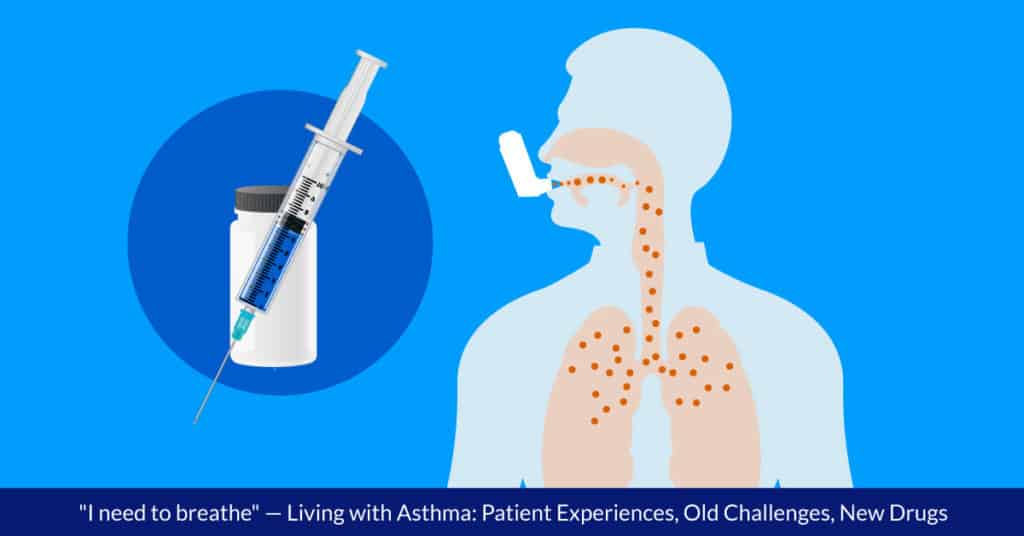“I need to breathe” — Living with Asthma: Patient Experiences, Old Challenges, New Drugs

Earlier this month, the American Lung Association (ALA), Inspire’s partner for the “Living with Asthma” online community, announced that it is looking for patient panelists to participate in a PFDD (Patient-Focused Drug Development) meeting on Pediatric Asthma, to be held virtually on 9/20/2021.
“The meeting will consist of an overview of pediatric asthma, an explanation of the Food and Drug Administration’s PFDD meeting process, and two panel sessions,” explained Annette Eyer, the ALA’s National Assistant Vice President of Patient Engagement. Co-hosts with the ALA include the Allergy & Asthma Network, the American Partnership for Eosinophilic Disorders, and the Asthma and Allergy Foundation of America. For more information about participation, people can email Ms. Eyer at annette.eyer@lung.org.1
Part of the FDA’s PFDD Initiative, FDA-led PFDD Public Meetings feature a format designed to engage patients and elicit their perspectives on the most significant symptoms of their condition, its impact on daily life, and their current approaches to treatment. The PFDD began in 2012 to change the FDA drug development process to ensure that the drugs most important to patient lives received priority. As the FDA put it, “People living with a condition are uniquely positioned to inform the understanding of the therapeutic context for drug development and evaluation.”2
Patients and Caregivers on Inspire
This has been Inspire’s credo from the very beginning: that patients are experts by experience, and that the expertise has value to patients, caregivers, researchers, and to the world at large.
An estimated over 111,000 people come to Inspire for help with asthma. Members discuss not only symptoms and treatments, but the social and emotional impact of having asthma:
I [was] recently admitted in [date] for severe asthma for two weeks. …Currently I am 3 weeks after discharge, yet I still… need two hours of not moving and talking for the spasm to completely break. Its currently affecting my mental health and I am getting frustrated with how slow the recovery is. I am progressing, but is painfully slow, its taking a toll on me and my job. I feel lucky so far my superiors are understanding regarding my asthma, but not my colleagues.
According to the ALA, more than 26 million Americans have asthma, including 6.1 million children, for whom it is the third leading cause of hospitalization. All forms of asthma chronically cause episodes of inflammation in the lung tissue that result in breathing difficulties, which can usually be controlled with quick relief medications (such as inhalers) or with longer term anti-inflammatory medications such as oral corticosteroids. It is fortunate that there is medication to address inflammation, because common triggers include widely varying allergens, infections, irritants, and even exercise and emotion.3,4
About 5-10% of the asthma population experiences severe asthma. Severe asthma is distinguished from uncontrolled asthma; uncontrolled asthma is improved by the typical medications, where severe asthma remains difficult to control despite the use of high doses of inhaled corticosteroids and other medications. Severe asthma is divided into three categories: allergic, non-eosinophilic, and eosinophilic asthma (EA). Up to 60% of those with severe asthma have EA, which is related to a type of white blood cell, and was discussed in a previous Patient Pulse blog.
Socioeconomic and Ethnic Disparities
Research has found that economic disadvantage is one of the risk factors for asthma and that asthma disproportionately affects ethnic minorities. A 2012 study stated that childhood asthma was more prevalent among Puerto Ricans and non-Hispanic blacks (19.2% and 12.7%) than it was in non-Hispanic whites and Mexican-Americans (8%, 6.4%). The same study found that the prevalence of asthma was higher among people of lower socioeconomic status (SES) and concluded that the disparities could be influenced by differences in both individual factors (ethnicity) and in community factors including the prevalence of cigarette smoke, quality of housing, and access to health care. For example, the ALA cites cockroach allergens as one environmental factor presenting an indoor air quality problem that contributes to both allergies and asthma. This factor is independent of ethnicity but associated with poorer quality housing.5,6
I read thru the older posts about air purifiers and it seems like the [product] is a big contender. Next, I am also looking into the [product]]. I am hypersensitive to smoke and my neighbor’s smoking seeps thru my walls. Anyone uses either of these products or a comparable product you recommend. I need it as powerful (and quiet maybe) as possible without looking at the price tag. I know that eliminating triggers is the best thing, but until I can relocate, I need to be able to breathe.
Latest developments
For severe asthma sufferers, triggers as mundane and ubiquitous as second-hand smoke can initiate life-threatening respiratory inflammation. Because this inflammation is not easily controlled, researchers continue to identify biomarkers that trigger asthmatic reactions with the hope of staving off the inflammatory chain reaction. There are now drugs targeting specific biomarkers in severe asthmatics such the monoclonal antibodies mepolizumab and reslizumab, both of which target the biomarker eosinophil that is present in the majority of people with SA.
In May, the New England Journal of Medicine published the results of a Phase 3 study on a monoclonal antibody biologic drug called tezepelumab that targets the biomarker thymic stromal lymphopoietin (TSLP). The results are encouraging because TSLP is involved in a variety of inflammatory processes all associated with asthma. It is hoped that this drug will broaden the population of asthmatics who can benefit from biologics. Last year, researchers also identified a biomarker that had not previously been associated with asthma, caspase-11, as an inflammasome, offering another path of drug investigation.7,8,9
Advances are critical for patients like these, who feel that they are “running out of options”:
I’m a 26 year old who has a history of relatively controlled asthma for most of my life. In fact up until recently I’ve only needed my inhaler or neb during colds which I rarely get. When I was younger peanuts, dogs and physical activity would trigger my asthma and I would need a puff of [treatment]. However, recently my asthma has been nothing I’ve ever experienced before especially in the last three months. [Three different] meds are not working and I’m literally just taking them to take them…Has anyone dealt with asthma like this where it’s controlled for years then all of sudden nothing is working?
The new classes of drugs that identify and target the very sources of asthmatic inflammation may bring widespread relief to millions of people who just want to breathe freely.
Inspire offers a trusted community to patients and caregivers. Our goal with this blog, this website and our content is to provide the life science industry access to the true, authentic patient voice. In so doing, we support faithful operationalization of patient-centricity. Take a look at our case studies, eBooks and news outlet coverage.
References
1https://www.inspire.com/groups/living-with-asthma/discussion/pediatric-asthma-parent-panelists-needed-for-9-20-21-meeting/
2https://www.fda.gov/industry/prescription-drug-user-fee-amendments/fda-led-patient-focused-drug-development-pfdd-public-meetings
3https://www.lung.org/lung-health-diseases/lung-disease-lookup/asthma/learn-about-asthma/severe-asthma
4https://www.lung.org/lung-health-diseases/lung-disease-lookup/asthma/living-with-asthma/managing-asthma/reduce-asthma-triggers
5https://www.lung.org/clean-air/at-home/indoor-air-pollutants/cockroaches#:~:text=Not%20only%20do%20cockroach%20allergens,develop%20in%20preschool%2Daged%20children
6Forno, E., & Celedón, J. C. (2012). Health disparities in asthma. American journal of respiratory and critical care medicine, 185(10), 1033–1035. https://doi.org/10.1164/rccm.201202-0350ED
7https://medicalxpress.com/news/2021-05-drug-tough-to-manage-asthma.html
8https://www.nejm.org/doi/full/10.1056/NEJMoa2034975
9https://www.sciencedaily.com/releases/2020/02/200226080629.htm






